Main Outcomes
To facilitate delivery, NanoFASE is coordinated (WP11) through a set of WPs linked through the common aim, objectives and concepts of the project. In short the project will be guided from the stakeholder focused WP1, which will initially draw up the outline specification for the Exposure Assessment Framework. WP1 will, with the other two crosscutting WPs (WPs 2 and 3), enable and drive overall scientific coordination and delivery around the common goal of framework development.
To date WP1 has produced an outline of the exposure assessment framework (EAF). Development of the EAF will continue throughout the course of the project until it launches in June 2019 (Deliverable D1.3). In the last year, a range of particle producers, regulators and academic experts have been consulted with regard to the format, scope and stakeholder/user community likely to utilize this framework.
A second major deliverable (D1.2) from WP1 (in collaboration with WP4 and the industrial partners in the project) was to produce a report on a pathway analysis along and beyond the product value chain to establish for our case study particles (i) potential release points to the environment (with WP4, 5) and (ii) potential pathways through the environment following disposal/release (with WP2, 6–9) to develop real case study profiles of production, use and disposal of ENMs. We have included the source, volume and type of starting material (nanoparticles and coatings), how this is incorporated into products and transported, market details and disposal options where known. This will inform WP2 on model development and integration. The D1.2 Report is being significantly expanded in a draft publication and includes collating industrial case study examples from the multitude of other related projects in FP7 and H2020. Distillation of information provided in WP4 has led to WP1/WP4 combined efforts to ensure outputs from the other experimental work packages can be used in real examples of ENM use within the clickable framework.
"Feedback on case study development" has been submitted (D1.5; due September 2018). Where available current uses were included in this report as well as near–market developments and products in the pipeline which will be improved by reducing the particle size of the active ingredients to the nano scale. WP1 continues to guide the experimental work packages to focus on the issues that industry and regulators prioritise and to ensure as much as possible consistency across WPs 5-9 in terms of choice of nanomaterials to use in experiments. Throughout the project WP1 will continue to have a pivotal role and will work closely with the other partners in the project and external stakeholders including industry, regulators and government departments to ensure the quality, effectiveness and ease of use of the outputs. WP1 is moving into the phase of actually building the first case study example into the clickable framework on the internet platform with WP10, using experimental results obtained in WP4-9.
WP2 is responsible for developing the spatially-explicit modelling frameworks, for predicting nanomaterial fate and biouptake in the environment, that form core outputs of the NanoFASE project. To do this, we are developing two complementary modelling systems. For screening level assessment we will further develop the SimpleBox4Nano model. SimpleBox4Nano is a nanomaterial-specific development of the SimpleBox model, which underpins the EU’s chemical risk and safety decision-support tool EUSES. For the more complex, spatially explicit fate and biouptake assessment, we will develop a coupled, gridded, soil-water-sediment transport framework with descriptions of nanomaterial transport, transformation and biouptake – the NanoFASE model.
The aim of developing a new, nanomaterial-specific model is to take advantage of state-of-the-art approaches to model structuring, specifically the concept of object–orientation. This allows the physical structure of the environment (including nanoparticle populations) to be represented in code by a structured collection of discrete ‘objects’ (Fig. 1). It permits an efficient separation of transport and transformation algorithms for nanoparticles. It also allows the definition of a nanoparticle ‘type’, i.e. the set of algorithms that describe the behaviour of a specific group of nanoparticles having common transformation behaviours. New types will be readily added to the model system, and existing types extended, making the NanoFASE model able to be extended to consider types of nanoparticles not yet subject to environmental release.
The development of the NanoFASE model follows a clear set of stages and milestones:
• Development of a written specification for the model (D2.1; completed November 2016). This document is the blueprint for the actual coding work, including connecting the model to the atmospheric compartment (WP6) and the product value chain and managed waste sources (WP4, WP5).
• Gridded spatial transport model for the soil and water compartments; (D2.2; completed December 2017). Linking and testing of the soil and water compartments is in progress.
• Initial incorporation and parameterisation of algorithms for the transformation and biouptake of nanoparticles within soils, waters and sediments. A set of algorithms for the behaviour of a non-transforming nanomaterial in soils and waters was incorporated and demonstrated in March 2018. This set will be extended to include algorithms for transforming nanomaterials by March 2019.
• Initial testing of the model, including testing against specific case studies (WP1). A small scale demonstration of the model was completed in March 2018, and a large scale demonstration for a real catchment (the River Thames, U.K.) will be usable from October 2018. Initial demonstrations for the Thames will use spatial distribution maps of nanomaterial emissions to the environment (WP4) from all uses of specific materials. In collaboration with WP1 and WP4, spatial emission maps for specific case studies will be used to produce additional demonstration model runs.
•Final updating and parameterisation of algorithms, final testing against case studies.

Figure 1: Proposed object structure for the soil and water components of the NanoFASE model.
WP3 contributes centrally to the project through its overarching aim to ensure timely supply of ENMs and their environmentally aged (functional fate form) variants to each of the environmental receptors workpackages (WP5-WP9) and the characterisation of all NanoFASE ENM under the relevant exposure conditions. WP3 is also integrating the Standard Operational Procedures (SOPs) for characterisation of ENM including so-called Functional Fate Assays, which aim to quickly and simply understand the environmental transformations and final forms of ENMs in each of the different environmental compartments, including their associated biomolecule coronas. WP3 in responsible for managing and integrating the NanoFASE datasets to facilitate linking of the ENM physico-chemical characteristics under different environmental conditions to their fate and behaviour data, including speciation and bioaccumulation. All NanoFASE data will be incorporated into the NanoFASE Knowledge Base, thereby ensuring harmonisation of fate and (previously generated) hazard data on the common ENMs (see below for more details).
As providers of nanomaterials, both industrial ones for real world relevance and bespoke synthesized NMs to allow more controlled experiments suitable for parameterization of the models, WP3 has played a central role in the project, but now as we enter the final year of the project WP2 is focussed on compilation of the characteriation dossiers for each of the NMs developed and provided, and on collection of the protocols utilised in the testing of the NMs transformations in each of the environment compartments. The final task of WP3 is the collection of the data in the tempaltes designed by WP3 in collaboration with WPs 5-9, to feed the data into the NanoFASE KnowledgeBase for access and preservation of the data long term.
A snapshot of some of the key NMs developed and utilised in the project is provided here :
Silver nanoparticles are widely used in a range of products, and are thus expected to be one of the largest NM fractions in the environment, however, not as Ag0 NMs given their large propensity for transformation, including dissolution and reprecipitation, and sulfidation leading to insoluble Ag2S NMs. Partner AppNano have been busy scaling up synthesis of spherical 20nm Ag2S NMs to the gram-scale as a first proxy for transformed Ag0 NMs, with the caveat that the Ag2S particles resulting from waste water treatment plants (for example) are often hollow in the centre (as a result of dissolution) and typically horn shaped due to re-precipitation of Ag2S in a non-symmetric manner. All partners in WP9 (bioaccumulation across a wide variety of organisms and plants) are utilizing these NMs. These NMs also featured in the mesocosm studies of WP9.
Another significant challenge faced in the project has been the development of Titanium dioxide NMs that could be experimentally distinguished from the background TiO2. Since TiO2 is one of the most ubiquitous oxides in the environment, UoB proposed the development of core-shell particles of a rare earth element core (for tracking and distinction from background particles) surrounded by a TiO2 (or CeO2) shell. Initial proposals for the rare earth element included holmium or hafnium (with europium also attempted by a commercial producer of particles), but in all cases the particles were not successful as core-shell particles. The justification for the core-shell approach rather than just doping was to keep the shell identical to the undoped particles thereby allowing for direct comparison. After significant trial-and-error, an optimized protocol was developed to produce NaHoF 4@TiO2@TiO2 NMs – a double shell approach was utilized as the initial TiO2 shell was just a couple of nm thick, which was considered too thin to ensure environmental behavior similar to pure TiO2 NMs. These NMs will be utilized in experiments in WP5 to track NMs ageing and transformation during waste water treatment. A publication describing the scaled-up synthesis and demonstrating their applicability for tracking the engineered NMs in a complex medium with a high background of Ti, in this case river water, has been submitted for publication.
A range of other NMs have been produced by partners Promethean particles for the consortium, including bare and PVP capped CeO2, Fe2O3 and Fe3O4, TiO2, and CuO NMs, which are being utilized in the experiments on fate and behavior of NMs in aquatic and soil compartments (WPs 7 and 8). The role of capping agent as stabilizer, and its fate during particle ageing in the different environmental compartments (including during waste water treatment) is a key topic of investigation within NanoFASE. Additionally, gold NMs of 20 and 80 nm have been utilized in a number of WPs (WP5, WP8 and WP9) as an insoluble, and easily detectable (e.g. by ICP-MS) material, and is being used, for example, to confirm that no uptake of NMs by isopods occurs (WP9, partner UniLj with UoB). Dyspium-doped copper hydroxide nanorods (Dy-Cu(OH)2) were successfully synthesized by UoB to allow detailed tracking of the fate and trasnforamtions in soil mesocosms (WP9) as part of the nanopesticides case study. Copper hydroxde is widely used as a nano-pesticide material, and thus understanding their uptake by soil organisms and plants under realistic exposures (mesocosms) is a critical aspect for NanoFASE case study development. Figure 2 provides images of the Dy-labelled Cu(OH)2 rods confirming that the Dy is distributed throughout the Cu(OH)2 nanorods, as required.

Figure 2: EDX imaging of the Cu(OH)2 wires indicating the overlap of the Dy signal and the Cu signal, confirming that the Dy is distributed throughout the Cu(OH)2 wires.
WP4 contributes to the transversal NanoFASE modelling and experimental work aiming to predict the quantities and forms of ENM released to each environmental compartment at all the life cycle stages of nano-enabled products.
Regarding the modelling work, quantification of ENM releases per EU country has been performed, covering TiO2, ZnO, Cu and Cu compounds, Ag and carbon black. Specifically, the emission inventory included emissions from ENM production (e.g. release to outdoor air or to waste water system), emissions from nano-enabled product manufacturing (e.g. release of ENM from paint factories) and emissions during use (e.g. release of ENM from outdoor paints). These flows are referred to 2016 and are described in D4.1. These numbers are being used to generate emission maps with higher spatial and time resolution, which will directly feed into the overall NANOFASE model (WP2). Moreover, work is now focused on defining the forms of ENM released during their life cycle (for Ag and TiO2).
Besides that, a catalogue of accidental release scenarios by considering various features such as magnitude of loss of containment, type of material, quantity, release, duration or meteorological conditions is being elaborated. With this aim, the ARAMIS risk analysis methodology was adapted to identify potential sources of ENM release within plant processes and storage equipment and different criteria have been defined to rank industrial processes with respect to their potential for ENM emission. Finally, a catalogue structure has been built as an OWL (Web Ontology Language) file where different types of scenarios were defined and their attributes and relations specified.
Concerning the experimental work, WP4 has tested 6 different products containing ENM, which are listed in Table 1. These products have been supplied by the industrial partners in NANOFASE. For each product, different scenarios have been tested following standardized protocols in order to determine the potential release of ENM during their use and end-of-life phases.
From the different experimental simulations release rates as well as release forms has been obtained, which can be used as input in risk assessment models and tools, including the model being developed in NANOFASE. Results are included in D4.2.
Table 1: Nano-enabled products tested in NANOFASE (WP4) and its corresponding simulations
|
Nano-enabled product |
ENM |
Simulation |
|
Antifouling paints |
Cu0 and Cu2O |
Immersion in water |
|
Road coating |
TiO2 |
Weathering and wheel abrasion |
|
Camping tents |
Ag |
Leaching |
|
Curtains |
TiO2 |
Household washing |
|
Textiles |
Ag |
Household washing |
|
Conductive ink |
Ag |
Leaching |
- Antifouling paints: widely used in boats. The main component is Cu (in different forms) which enters into the environment after Cu2+ release from the painted surface. Painted panels containing different Cu-based particles were synthesized at industrial scale and the release behaviour when immersed in water has been studied.
- Photocatalytic road coatings: weathering and stresses produced by wheel abrasion can damage the coating causing ENMs release. The coating has been applied in asphalt samples which have been introduced in a climatic chamber alternated with wheel abrasion simulations. Water from the climatic chamber has been collected and analysed to study ENMs release (Fig. 3).
- Camping tents: textiles containing a polyacrylate layer with embedded Ag nanoparticles have been prepared at pilot scale. Leaching experiments were performed simulating a landfill scenario.
- Curtains: water contact and mechanical stress produced during household washings can lead to ENMs release, which might end up in waste water treatment plants. Curtain textiles containing nanoparticles were washed several times and both washed textiles and washing waters were analyzed to determine the content and form of release.
- Textiles: cotton textiles with two Ag nanomaterials of different morphology (nanoparticles and nanowires) have been produced at pilot scale. The effect of household washing on ENMs release has been evaluated.
- Conductive inks: leaching experiments have been performed on printed circuits simulating a landfill scenario.
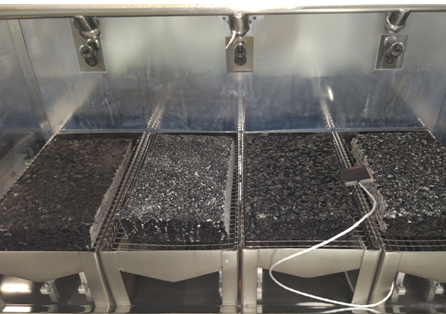
Figure 3: Asphalt samples inside the climatic chamber.
WP5 continues to establish transformation and release rates of ENM during their passage through different reactors. We are focusing on wastewater treatment plants (WWTPs), solid waste and dedicated sewage sludge incinerators as well as landfills (Fig. 4). Additionally, lab-scale experiments using pristine and well characterized materials, representing the realistic fate relevant forms at each stage, will allow us to obtain a mechanistic understanding of the transformation processes in waste treatment reactors. Our experimental results will feed directly into the development of a mathematical model describing the transformation and transfer of ENMs through the investigated reactors.
WWTPs are major hubs for ENMs released from consumer products during their use phase. To increase our understanding of how ENM move through and transform in WWTP, we spiked a pilot WWTP with selected ENMs over a period of several months. The transfer of the ENMs through the WWTP was assessed by comparing the mass of selected ENMs leaving the WWTP to the mass of the respective ENM accumulated in the sludge phase. Results indicate a high correlation between the removal efficiencies and the amount of sludge lost via the effluent. These findings point towards a very efficient attachment of ENM to sludge flocs during the wastewater treatment. Complementary results from single particle ICPMS measurements will further reveal, whether particles are discharged as individual nanoparticles or as (homo-/hetero-) agglomerates. Following these initial spiking experiments, ENM enriched sewage sludge was incinerated or pyrolyzed in pilot facilities. The resulting ashes and biochars are being investigated for the presence of (transformed) ENMs and will be used for additional batch leaching and column experiments to simulate the release of ENM from deposited sewage sludge ashes.
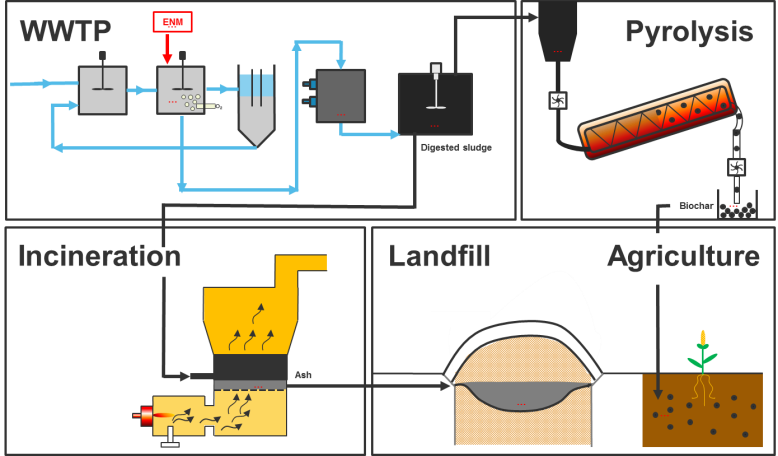
Figure 4: "Reactor" processes related to waste water treatment plants studied in WP5 of the NanoFASE project.
In deliverable 5.1, WP5 will report on completion of studies on ENM fate in wastewater treatment plants and degradation and exchange of particle coating. The main results will included fate process information and likely particle characteristics that will be used to produce bespoke particles to be produced in WP3 for use in environmental compartment focussed work packages.
The overall goal of WP6 is the investigation and description of ENMs in ambient air: their emission, transformation as well as their direct atmospheric impact. We measured the release of engineered metal oxide nanoparticles into the air from industrial facilities. Further, we are studying the photochemical effects of released TiO2 and CeO2 in a reaction chamber to investigate the effect of released nanoparticles on atmospheric chemistry. The experimentally determined emissions and reaction rates enable the modelling of atmospheric chemical reactions and the degradation of coatings under different conditions. The concentrations used in the local and regional model have been derived from an extended literature study that revealed severe knowledge gaps, which are closed by the abovementioned dedicated laboratory and field measurements. A general measurement strategy that showed promising results. The outcome of the literature review has been published in a review paper on emissions and possible environmental implication of engineered nanomaterials in the atmosphere and an international workshop of ENM fate in air was held in November 2017. The model Lotos Euros has been updated to model the effect of airborne nanomaterials on the atmosphere. Field measurements and lab-experiments are nearly finished and the data are used in the modelling.
WP7 develops a modelling framework for engineered nanomaterials in soils. Nanomaterials could reach soils mainly after the deposition of wastewater treatment sludge. This sludge contains much valuable organic carbon and nutrients for agricultural soils. Soils are therefore often considered a sink for nanomaterials, where concentrations develop over time.
WP7 has recently produced a research report on fate descriptors for nanomaterial as a function of soil properties, an important milestone for this WP. Much of the model development for soils revolves around developing fate descriptors, i.e. the physical parameters required for a model to calculate the different processes relevant for soils (Fig. 5), as well as the methods of how to determine them. One such fate descriptor for which a well-developed theory exists is the attachment efficiency, describing the chance a particle will stick if it comes into contact with the pore wall. A major time investment has been developing protocols to determine this parameter. Most commonly, column tests are used to develop the attachment efficiency and this was also the case in NanoFASE, but we have adapted the protocol to remove possible artefacts such as nanoparticle removal by anything other than the soil itself. Attachment efficiencies have also been determined using batch tests. These are a more direct way of determining the attachment efficiency and were developed in collaboration with DUKE University. With these optimized protocols, we found better correlations with the usual suspects in determining nanomaterial behaviour in the environment: their charge and ionic strength.
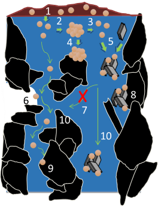
Figure 5: Soil processes considered in NanoFASE. 1. Homoaggregation. 2. Heteroaggregation. 3. Interaction with air/water interfaces. 4. Straining. 5. Attachment. 6. Bioturbation.
Through Monte Carlo modelling, we could explain some earlier observations that suggested heteroaggregation (Process 2 in Figure 5) indeed plays an important role in nanomaterial transport. We also found that attachment of nanomaterials in soils is not always irreversible, meaning that they can detach and thus, over longer time scales, end up in deeper groundwater layers. Soils are therefore hardly sinks as often assumed. Moreover, erosion and soil run-off displace particle from topsoil to nearby freshwater rivers.
Other major findings were the important role that air/water interfaces play in attaching nanomaterials (process 3 in Figure 5). Non-saturation of soils therefore plays an important role, meaning that saturated columns cannot fully reflect the situation in the field. Modelling field transport is extremely important when introducing nanozerovalent iron to remediate contaminated soils. These high concentrations enable different processes to be important such as homoaggregation (Process 1 in Figure 5) and a dedicated transport model was created for this by partner TUL.
A second model for non-intentional nanomaterial exposures is now being developed based on the insights gathered so far. This allows us to predict and classify the soil types that are most vulnerable should they be exposed to nanomaterials.
WP8 has developed a multidimensional parameter testing matrix after identifying the major driving parameters affecting the behaviour of ENMs in water (Fig. 6). The matrix consists of three dimensions: pH, natural organic matter (NOM) concentration and electrolyte concentration (represented by CaCl2/MgSO4 in a fixed 4:1 ratio). The parameters will be varied within ranges representative of water chemistries of European surface and coastal waters.
WP8 has selected a first set of ENMs for testing, chosen to represent different types of ENM reaction/behaviour types, while covering several ENMs relevant for the NanoFASE case studies. A common dispersion protocol for these ENMs was developed within WP8. WP8 has produced an overview of the main driving forces with respect to the behaviour of ENMs in surface waters (D8.2) which will be published as papers later in the project.
A small scale two-component cluster-cluster heteroaggregation model for studying interactions between ENMs and NOM has been developed. This model will be expanded to a three-component system, capable of modelling interactions between ENMs, NOM and inorganic colloids.
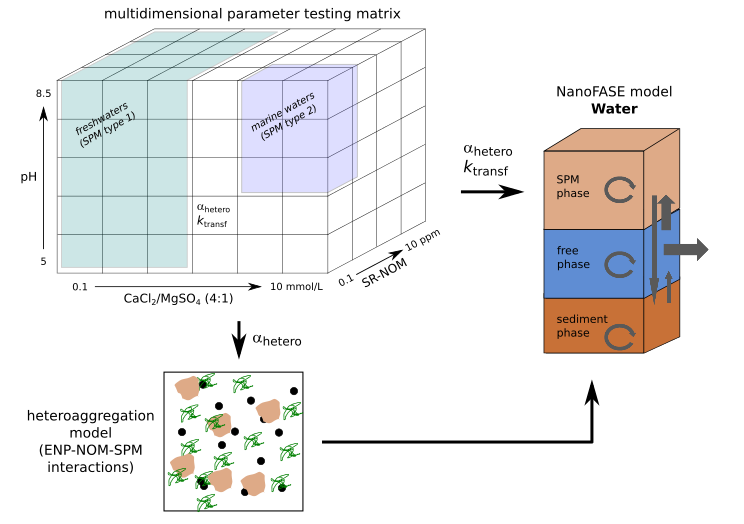
Figure 6: Design of multi-dimensional experiments to parameterize the NanoFASE water model, including a component heteroaggregation model.
Our next steps are to decide on suitable analytical methods to study heteroaggregation, dissolution and other transformation processes. To this aim, a thorough literature review on existing heteroaggregation methods has been performed and first approaches are being tested by different WP8 partners. Furthermore, a novel, infinite-sink approach to study CuO ENM dissolution is being developed within WP8 and compared with batch experiments. For the systematic investigation of heteroagglomeration processes in natural waters a near-natural analogue for natural suspended matter has been developed, which can be reproducibly produced and is stable for extended periods of time. The design of a dynamic reaction cell to study dissolution and transformation processes has been improved and builds the basis for experimental work and contributions of NanoFase to standardization.
The main objective of WP9 is to quantify the uptake of NMs in selected species (aquatic and terrestrial), and to assess the effect of ageing of NMs under environmentally relevant conditions on the uptake and bioaccumulation. The results of these experiment will then be used to develop predictive models. In this WP single species exposure experiments have been conducted with relevant species of both aquatic and terrestrial ecosystems, e.g. earthworm, isopod, meal worm, wheat and snail for terrestrial systems and algae, daphnids and fish for aquatic systems. These species reflect a wide array of different routes of uptake, and can be used to predict NM uptake in the most relevant invertebrate species from both terrestrial and aquatic ecosystems. The modelling is based on so-called physiological based kinetic models which can be used to quantify bioaccumulation of NM as the net-result from uptake and elimination processes (Figure 7).
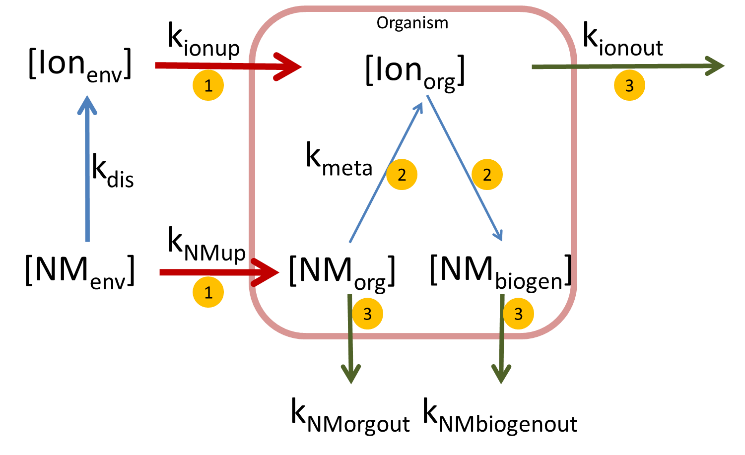
Figure 7: The conceptual model for accumulation modelling in organisms. [Ionenv]: ionic concentration of NP-material in environment [NMenv]: NM concentrations in environment. 1: Uptake of different forms of NM; 2: internal dissolution and biogenic formation of NM; 3: elimination of the different forms of NM.
The uptake experiments showed that uptake of dissolved metal ions is much larger than the particulate form. Furthermore, within organisms particulate NM may be formed biogenically, resulting in NM in the tissues of organisms, even when exposed to metals salts. This illustrates that particulate matter in organisms exposed to NM is not necessarily the same as the original NM it was exposed to. Based on the single species exposure experiments, uptake and elimination parameters have been quantified for different forms of NM, pristine as well as (artificially) aged, for a range of species. In 2018, mesocosm experiments have been conducted, both terrestrial as well as aquatic, in which the uptake and elimination kinetic parameters can be validated under environmentally relevant conditions. The experiments have been conducted successfully, and the first preliminary results indicate that the accumulation patterns in the mesocosms do indeed reflect kinetics in the single species experiments. Although the mesocosm experiments need to be discussed in much more detail, which will be performed the coming months, the preliminary results would suggest that the kinetic parameters derived in the single species tests may be used for modelling of uptake under environmentally relevant conditions.
Based in discussions among work packages within NanoFASE (WP2, WP7 and WP9) on the transport of NM within the soil, the potential role of bioturbation was identified, yet not a part of the proposed work. Nevertheless, experiments were conducted within WP9 in which the effect of bioturbation on the (vertical) transport of NM was quantified. This effects was significant, earthworm activity results in directed transport of NM in the soil. Jointly with WP2 and WP7 the results of these experiments will be included in the transport and fate models of NanoFASE. Results of WP9 on in vivo experiments up till month 34 show that 1) uptake and elimination kinetics of NM in different species can be modelled with (relatively simple) Physiological Based Kinetic models (PBK-models); 2) the derived PBK-models are most likely to be applicable under environmental relevant conditions, 3) biological activity of soil organisms (i.e. earthworms) has a significant effect on the (vertical) transport of NMs in the soil.
In addition to the in vivo work, WP9 partners have completed several in vitro experiments to derive the dynamic ranges of parameters that play a role in accumulation efficiency, uptake, and translocation of pristine and aged nanomaterials across a range of physico-chemical conditions, reflecting gut conditions of different species. The results of these experiments, together with the current state of the literature, are currently being drafted in an integrated review paper.
Within WP10, in close relation with WP11, the plans and the infrastructure for the integration, communication and dissemination of information were established at M6 and have been updated yearly. On the project website relayed on the NanoFASE social media accounts (Twitter: @NanoFASE_EU, LinkedIn, YouTube, Facebook), events, news and videos inform stakeholders about the project, its progress and its actors from the work package leader to the "young Scientist". Effective internal exchange of documents takes place through the Internal Communication Platform.
A web-based Clickable Framework (CFW) has been developed, a collective effort involving all the scientific partners and executed by WP10, where the outputs from NanoFASE are brought together around a graphically based access point publicly available on our project website. The live framework is considered as highly important and useful tool for demonstrating the NanoFASE results and will be maintained even after the end of the project period.
An open stakeholder workshop was held at Rome in May 2018 in coordination with SETAC 2018 to maximise both the exposure of the results and achievements of NanoFASE project and the utility of the CFW to the interested public and end user. Also, an industry webinar is planned on 20th November 2018 for the same. Information of and integration from the targeted stakeholders (industry, OECD, ECHA, scientists, consultants, regulatory… etc.) has taken place from the very start of the project, among others at conferences in and beyond Europe (ICEENN, Pacifichem, EuroNanoForum, SETAC) and at the Advisory Board meeting. These activities are planned and recorded in a dedicated tool. Continuous communication are also published in journals, at events, in our newsletter and also in NSC newsletters.
Navigate sections:
Overview Objectives Main Outcomes Approach Work Packages Impact
